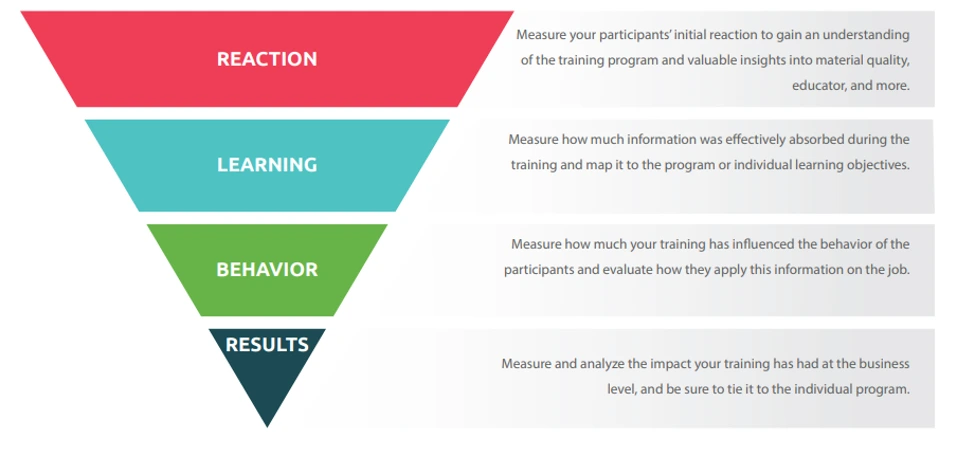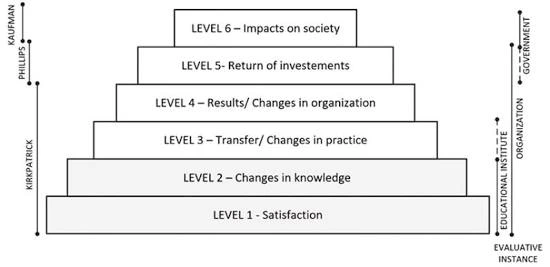Training evaluation refers to an attempt to obtain relevant information on the effects of a training program. It is considered an essential aspect of a training event to be able to reflect, analyze, and improve its effectiveness and efficiency.
The primary objective of evaluating any training program is to develop an understanding of whether it has achieved its stated objectives. There are several types of training evaluation methods and tools available that enterprises can use to evaluate and significantly improve the outcome of future training as well.
Also Read: 6 Best Remote Training Tools for Modern-Day Learners
Benefits of Evaluating Training and Development
Evaluation acts as a definite checkpoint to ensure that the training delivered is able to fill the competency gaps within the organization in a cost-effective manner. Some of the noteworthy benefits of training evaluation are:
- Accountability
Training evaluation brings in greater accountability by ensuring that training programs comply with all the competency gaps, and there is no compromise on deliverables.
- Transparency in Feedback
Evaluation of training programs also acts as a proper feedback mechanism for the trainer and the overall training process. Since evaluation mostly assesses individuals at the level of their work, it makes it simpler to understand the loopholes of the training so that required changes in the methodology can be implemented at the earliest.
- Cost-Efficiency
Evaluation of training and development ensures that the training programs bring in cost-efficiency in the system by effectively improving the work quality and development of new employee skills within a certain budget.
Also Read: How Can Enterprises Implement Simulation Training for Employees
Guide:
How to Build an eBook Store
Types of Training Evaluation Methods
There are several types of training evaluation methods to measure the effectiveness of enterprise training, such as surveys, post-training quizzes, participant case studies, and official certification exams.
Here we are discussing the top 5 proven methods that enterprises can use to measure training effectiveness –
- The Kirkpatrick Taxonomy Method
- The Philips ROI Model
- Summative and Formative Evaluation
- Kaufman’s Five Levels of Evaluation
- Anderson’s Model and Learning Evaluation
Related Read: 5 Ways to Boost Training ROI with Evaluation Tools
1. The Kirkpatrick Taxonomy Model
Kirkpatrick Taxonomy is one of the most widely used methods for evaluating the effectiveness of corporate training programs.
Developed and designed by Don Kirkpatrick, the framework offers a comprehensive four-level strategy to evaluate the effectiveness of any training course or program.
The four levels used in this are:
- Level 1: Reaction
This is the level where you gauge how the participants responded to the training given to them. To be able to identify if the conditions for learning were present, you can ask the participants to complete a short survey or feedback forms and gauge their reactions to training.
- Level 2: Learning
In the second stage, the idea is to understand what the participants learned from the training. In most cases, practical tests or short quizzes before and after the training are used to assess this.
- Level 3: Behavior
This is the stage that takes place a while after the training. In this stage, you try to assess whether the participants actually put what they learned into practice in their job roles. This can be done either by asking participants to complete self-assessments or by asking their supervisor to formally assess them.
- Level 4: Results
In the last stage, you need to evaluate whether the training met the stakeholders’ expectations by determining the return on the expectations, also known as ROE.
Also Read: How to Create Online Course Modules for Employee Training
2. The Phillips ROI Model
Very similar to the Kirkpatrick model in approach, the Phillips ROI model has an extra step, which is to evaluate the program’s return on investment (ROI) by measuring the difference between training cost and training results.
Here is the step-by-step procedure to calculate ROI as per this method:
- Collect the Pre-training Data
The first step here is to collect pre-program data as a baseline measure that allows you to compare metrics before and after training.
- Collect the Post-training Data
The next step is to collect post-training data through varied sources such as participants, organizational performance records, team/peer group, participants’ supervisors, and other internal/external groups.
- Isolate the Effects of a Training Program
At this stage, determine whether results discovered are actually due to the training program. Identify all the key factors that might have contributed to the performance improvement.
- Convert the Data to Monetary Gains
Once you’ve isolated the effect of the program, you need to convert the data to monetary values and compare it to the overall program costs.
- Calculate the Return on Investment
Use the formula below to calculate the return.
In case the training results exceed the cost, it is an indication of a positive training ROI. Whereas if the cost of training is more than the results, enterprises need to change their approach.
3. Summative and Formative Evaluation
A thorough evaluation can give you the best insight into the drawbacks of your training. So, it is also important to know how to assess a training program both while it’s being developed (formative evaluation), and after it has been delivered (summative evaluation).
How to Conduct a Formative Evaluation?
The steps to conduct a formative evaluation are:
- Reviewing the training materials with one or a group of trainees.
- Using the material in a situation similar to that of an actual training program to see the impact of the material.
- Holding group discussions with the trainees to gain feedback.
- Assessing the material with managers and supervisors who oversee trainees.
How to Conduct a Summative Evaluation?
Some of the steps to conduct a summative evaluation are:
- Testing trainees on how well they grasped the information provided.
- Asking trainees for their opinion about the training program after it has been delivered.
- Measuring changes in production and quality of work that has been accomplished post-training.
- Conducting surveys or interviews with each trainer to gain a better understanding of what they learned.
4. Kaufman's Five Levels of Evaluation
Kaufman’s Levels of Learning Evaluation is one of the other popular types of training evaluation methods that build on or reacts to Kirkpatrick’s model. The levels and considerations of this method are as below:
- Input – Kind of resources and learning materials that training teams have at their disposal that they can use to support the learning experience.
- Process – Focuses on the delivery of the learning experience in terms of its acceptance and how people are responding to it.
- Micro-Level Results – Takes into account if the learner or the learning group acquired the knowledge and applied it to their respective jobs.
- Macro-Level Results – Takes into account if the performance improvements are due to the learning and application of new skills in the workplace and what kind of benefits participants get from the learning at an organizational level.
- Mega-Level Impact – Considers the kind of impact that the learning has on society or larger external stakeholder groups.
Also Read: 8 Best Employee Engagement Strategies
5. Anderson's Model of Learning Evaluation
Yet another favorite type of training evaluation method, the Anderson model, helps businesses to keep their business strategy a priority. There are three stages to the Anderson Model:
- Stage 1: Evaluating your current training programs against the business’ strategic priorities.
- Stage 2: The stage of measuring the contribution of training to strategic business results.
- Stage 3: At this stage, you find the most relevant approaches for your company and decide whether the ROI is worthwhile.
If you’re not satisfied with the results of ROI measurement in stage 3, it’s time to make improvements to your training programs.
Best Practices for Conducting Training Evaluation
To ensure that your training evaluation is effective, there are several best practices that you should follow. These include:
- Determine the Purpose of the Evaluation: Before conducting the evaluation, it is important to determine the specific goals and objectives of the training program. This will help you to identify the most appropriate evaluation methods to use.
- Use Multiple Evaluation Methods: To get a comprehensive view of the effectiveness of your training program, it is recommended to use multiple evaluation methods. This can include surveys, observation, and performance appraisals.
- Collect Data from Multiple Sources: To ensure the validity and reliability of your evaluation, it is important to collect data from multiple sources, such as trainees, supervisors, and coworkers.
- Use a Standardized Evaluation Tool: To ensure consistency and comparability of results, it is recommended to use a standardized evaluation tool that has been validated and tested.
- Use the Results to Make Informed Decisions: The results of the evaluation should be used to make informed decisions about future trainings, such as identifying areas of improvement, modifying the training program, or discontinuing ineffective training programs.
To Conclude
Training evaluation basically helps organizations with the discovery of training gaps and opportunities in training their employees. The process of training evaluation boosts employee morale, helps improve overall work quality, and is essential to overall training effectiveness.
Each of the types of training evaluation methods discussed above has its own unique advantages and disadvantages. Finding the right one for your organization primarily depends on factors such as budget, time, and the availability of the resources.
Contact our expert team now.
To know more, please write to us at KITABOO@hurix.com.
Suggested Reads:
- 10 Advantages of eBooks Over Printed Books for Better Reading
- Online Education vs Traditional Education – Which One is Better?
- Top 9 Online ePUB Readers for Windows OS Users
- 11 Best Apps to Read PDF Books on Android Devices
- 8 Best eBook Hosting Platforms For Digital Publishing
- How to Create a DRM Protected eBook and Distribute it Securely
- Digital eBook Libraries
- Interactive Workbooks for Schools
DISCOVER HOW TO ENGAGE AND RETAIN MEMBERS WITH INTERACTIVE DIGITAL CONTENT
Kitaboo is a cloud-based platform to create, deliver & track mobile-first interactive training content.
You May Also Like













